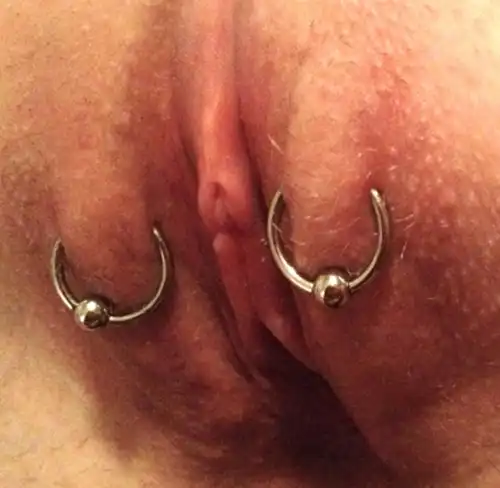Outer Labia Piercing in Nairobi, Kenya
Outer labia piercings, are a type of genital piercing that involves piercing the outer folds of the vulva, known as the labia majora. These piercings can be placed at various points along the outer edge of the labia majora, typically using a small gauge needle or piercing instrument.
Like other genital piercings, outer labia piercings can be purely aesthetic or may also provide added stimulation during sexual activities. The choice of jewelry for outer labia piercings varies, with options including captive bead rings, circular barbells, or curved barbells, depending on personal preference and anatomy.

Outer Labia Piercing
At Rebel Inks Tattoo, Tattoo Removal, and Body Piercings Parlour we have reputable and experienced piercers who follows strict hygiene and safety protocols. Proper aftercare is essential to promote healing and reduce the risk of infection, which may include cleaning the piercing with saline solution and avoiding tight clothing or excessive friction during the healing process.
It’s also important to note that outer labia piercings, like all genital piercings, can carry some risks, including pain, swelling, bleeding, and potential complications such as infection or migration. Individuals considering outer labia piercings should thoroughly research the procedure, discuss any concerns with a professional piercer, and carefully weigh the potential risks and benefits before making a decision.
Outer Labia Piercing Procedure
The outer labia piercing procedure, like any genital piercing, requires careful attention to hygiene, expertise, and precision. Here’s a general overview of how the procedure typically unfolds:
- Consultation: Before the piercing takes place, our piercer will conduct a thorough consultation with the client. This is an opportunity to discuss the piercing placement, jewelry options, aftercare instructions, and any questions or concerns the client may have.
- Preparation: Our piercer will sanitize the piercing area and the tools to be used. They may also mark the placement of the piercing with a surgical marker to ensure accuracy and symmetry.
- Positioning: You will then be positioned comfortably, typically lying down or seated with proper support. Our piercer will gently manipulate the outer labia to access the desired piercing site.
- Piercing: Using a sterile needle or piercing instrument, our piercer will swiftly and precisely create the opening for the jewelry. The piercing itself may cause some discomfort or a brief stinging sensation, but it is generally tolerable for most individuals.
- Inserting Jewelry: Once the piercing is made, our piercer will carefully insert the chosen jewelry into the opening. Common jewelry options for outer labia piercings include captive bead rings, circular barbells, or curved barbells.
- Aftercare Instructions: After the piercing is complete, our piercer will provide detailed aftercare instructions to promote proper healing and minimize the risk of infection. This may include cleaning the piercing with saline solution, avoiding certain activities or products that could irritate the piercing, and keeping the area clean and dry.
- Follow-Up: Our piercer may schedule a follow-up appointment to check on the healing progress and ensure that the piercing is healing properly. They may also offer additional guidance or support if needed.
At Rebel Inks Tattoos, Tattoo Removal, and Body Piercings Parlour we have a team of reputable and experienced piercers who follows strict hygiene protocols and uses sterile equipment to minimize the risk of complications. Following proper aftercare instructions will be crucial for promoting healing and reducing the risk of infection.
Considerations before getting an Outer Labia Piercing
Before getting an outer labia piercing, it’s essential to carefully consider several factors to ensure it’s the right choice for you. Here are some important considerations:
- Placement and Anatomy: Everyone’s anatomy is unique, so it’s crucial to consult with an experienced piercer to determine the most suitable placement for your outer labia piercing. Factors such as tissue thickness, blood flow, and potential interference with clothing or daily activities should be taken into account.
- Pain and Sensitivity: Genital piercings, including outer labia piercings, can be more sensitive and painful than piercings in other areas of the body. Consider your pain tolerance and sensitivity levels, and be prepared for some discomfort during and after the piercing procedure.
- Healing Time: Genital piercings typically take longer to heal compared to piercings in other areas of the body. Outer labia piercings may take several weeks to several months to fully heal, during which time you’ll need to practice diligent aftercare to prevent infection and promote healing.
- Potential Risks and Complications: Like any piercing, outer labia piercings carry some risks, including pain, swelling, bleeding, infection, and potential complications such as migration or rejection. It’s essential to thoroughly research the procedure, understand the potential risks, and discuss any concerns with your piercer before proceeding.
- Lifestyle and Activities: Consider how a genital piercing may impact your lifestyle, activities, and personal hygiene routines. Certain activities such as vigorous exercise, sexual intercourse, or wearing tight clothing may need to be avoided or modified during the healing process to prevent irritation or injury to the piercing.
- Personal Preferences and Aesthetics: Outer labia piercings can be purely aesthetic or may also provide added stimulation during sexual activities. Consider your personal preferences, style, and reasons for wanting the piercing, and ensure that it aligns with your desired aesthetic and lifestyle.
- Professional and Experienced Piercer: Choose a reputable and experienced piercer who specializes in genital piercings and follows strict hygiene and safety protocols. Ask for recommendations, research the piercer’s credentials and reviews, and schedule a consultation to discuss your concerns and ensure you feel comfortable and confident before proceeding.
Carefully considering these factors and making an informed decision, you can ensure that getting an outer labia piercing is a positive and rewarding experience for you.
Outer Labia Piercing Pain and Healing
Pain and healing are important considerations for anyone contemplating an outer labia piercing. Here’s what to expect:
Genital piercings, including outer labia piercings, typically involve a level of discomfort during the piercing procedure itself. While pain tolerance varies from person to person, many individuals describe the sensation as a sharp pinch or stinging sensation that lasts for a few seconds. However, the pain is usually brief and manageable for most people. It’s essential to communicate openly with your piercer about your pain tolerance and concerns before the procedure begins.
Outer labia piercings, like other genital piercings, require patience and diligent aftercare to heal properly. Healing times can vary, but you can generally expect the piercing to take several weeks to several months to fully heal. During this time, it’s essential to follow your piercer’s aftercare instructions carefully, which may include cleaning the piercing with saline solution, avoiding tight clothing or excessive friction, and abstaining from sexual activity until the piercing is fully healed.
While outer labia piercings can be more sensitive and may require a longer healing period compared to piercings in other areas of the body, many people find that the discomfort is outweighed by the aesthetic and potential sensual benefits of the piercing. As always, it’s crucial to choose a reputable and experienced piercer, communicate openly about your concerns and preferences, and prioritize proper aftercare to ensure a smooth and successful healing process.
Outer Labia Piercing Aftercare
Proper aftercare is crucial for ensuring the successful healing of an outer labia piercing. Here’s a guide to help you navigate the aftercare process:
- Cleanliness: Wash your hands thoroughly with antibacterial soap before touching your piercing. Use a gentle, fragrance-free soap or saline solution to clean the piercing twice a day. Gently lather the area around the piercing, ensuring to remove any crust or debris. Rinse with warm water and pat dry with a clean, disposable paper towel or let it air dry.
- Avoid Irritants: Avoid using harsh cleansers, alcohol, hydrogen peroxide, or ointments on your piercing, as these can irritate the skin and delay healing. Avoid swimming in pools, hot tubs, or natural bodies of water until your piercing is fully healed to prevent exposure to bacteria and other contaminants.
- Clothing and Hygiene: Wear loose, breathable clothing to avoid friction and irritation around the piercing site. Avoid wearing tight underwear or clothing that may rub against the piercing. Keep the area clean and dry, and avoid touching or rotating the jewelry unnecessarily.
- Hygiene Practices: After urination or bowel movements, gently pat the piercing dry with a clean tissue or cotton pad. Avoid using wet wipes or toilet paper with added fragrances or dyes, as these can irritate the piercing.
- Sexual Activity: Refrain from sexual activity, including vaginal intercourse, oral sex, and masturbation, until your piercing is fully healed. Sexual activity can introduce bacteria and increase the risk of irritation or infection.
- Avoiding Trauma: Be mindful of activities that may put strain on the piercing, such as vigorous exercise, biking, or sitting for long periods. Avoid activities that involve direct pressure on the piercing, such as horseback riding or using certain exercise equipment.
- Follow-up Care: Schedule follow-up appointments with our piercer as recommended to monitor the healing progress and address any concerns or complications. If you experience excessive swelling, redness, pain, discharge, or signs of infection, Contact Us promptly.
By following these aftercare guidelines and maintaining good hygiene practices, you can promote healing and reduce the risk of complications with your outer labia piercing. If you have any questions or concerns about your piercing or aftercare routine, don’t hesitate to Contact Us for guidance and support.
Outer Labia Piercing Jewelry
Choosing the right jewelry for your outer labia piercing is essential for both aesthetics and comfort. Here are some common jewelry options:
- Captive Bead Ring (CBR): This classic option features a hoop with a removable captive bead or ball closure. CBRs come in various sizes and materials, including stainless steel, titanium, and gold. They offer versatility and can be worn in different orientations for a personalized look.
- Circular Barbell: Similar to a CBR but with two removable beads or balls on either end, circular barbells create a sleek and minimalist look. They are available in different gauges and lengths to suit individual anatomy and style preferences.
- Curved Barbell: As the name suggests, curved barbells feature a curved shaft with removable beads or balls on either end. They are designed to follow the natural curve of the outer labia, providing a comfortable fit and a streamlined appearance.
- Straight Barbell: While less common for outer labia piercings, straight barbells can still be an option, especially for vertical placements or specific anatomical considerations. They offer a simple and understated look and are available in various lengths and materials.
- Surface Barbell: Surface barbells are specifically designed for surface piercings and are ideal for placements where the jewelry rests flat against the skin. They feature a straight bar with two or more holes for threading, providing stability and reducing the risk of migration or rejection.
- Custom Jewelry: For a truly unique and personalized touch, consider custom jewelry options such as threaded ends with gemstones, decorative beads, or intricate designs. Custom jewelry allows you to express your individual style and personality while ensuring a perfect fit for your piercing.
When selecting jewelry for your outer labia piercing, it’s essential to choose high-quality materials such as implant-grade titanium, surgical steel, or 14k or 18k gold to minimize the risk of irritation or allergic reactions. Additionally, consider factors such as gauge size, length, and style to ensure a comfortable and aesthetically pleasing fit. Consulting with an experienced piercer can help you navigate your options and find the perfect jewelry for your piercing.
Cost of an Outer Labia Piercing in Nairobi, Kenya
The cost of an outer labia piercing can vary depending on several factors, including the location, reputation, and expertise of the piercing studio, as well as the type of jewelry chosen. Here’s a breakdown of potential costs:
- Piercing Fee: The piercing fee typically covers the cost of the procedure itself, including the piercer’s time, expertise, and use of sterile equipment. This fee can vary widely depending on the studio and location.
- Jewelry Cost: The cost of the jewelry used for the outer labia piercing can vary depending on the type, material, and quality of the jewelry chosen. Basic jewelry options such as captive bead rings or circular barbells are reasonably affordable, while higher-end or custom jewelry options can cost significantly more.
- Aftercare Products: While some piercing studios may include basic aftercare products such as saline solution or cleaning instructions in the piercing fee, others may charge separately for these items. Expect to spend an additional amount on aftercare products, depending on the studio’s policies and the quantity of products provided.
At Rebel Inks Tattoos, Tattoo Removal, and Body Piercings Parlour our piercers may offer additional services or perks as part of the piercing package, such as consultation fees, aftercare products, or follow-up appointments. These services can impact the overall cost of the piercing experience.
Overall, the total cost of an outer labia piercing can vary, depending on the factors mentioned above. At Rebel Inks Tattoos, Tattoo Removal, and Body Piercings Parlour we are open to inquiries from our clients about our pricing and policies, more so we are a reputable studio with experienced piercers and a commitment to safety and hygiene. Remember that investing in a quality piercing experience can help ensure a smooth and successful outcome for your piercing.


Possible side effects of Outer Labia Piercing
Outer labia piercings, like any piercing, carry some risk of side effects or complications. It’s essential to be aware of these potential risks before getting a piercing. Here are some possible side effects of outer labia piercings:
- Pain and Discomfort: Immediately after the piercing procedure, it’s normal to experience some pain, swelling, and tenderness around the piercing site. This discomfort usually subsides within a few days but may persist for longer in some cases.
- Bleeding: Minor bleeding is common during and immediately after the piercing procedure. However, excessive bleeding or prolonged bleeding may indicate a problem and should be addressed promptly.
- Infection: Infections can occur if bacteria enter the piercing site, either during the piercing procedure or during the healing process. Signs of infection include increased pain, swelling, redness, warmth, discharge, or the presence of pus. If you suspect an infection, seek medical attention promptly.
- Migration and Rejection: Piercings placed in areas with high movement or friction, such as the outer labia, may be more prone to migration or rejection. Migration occurs when the body pushes the piercing outwards, while rejection occurs when the body completely expels the jewelry. Signs of migration or rejection include the piercing becoming shallower over time or the jewelry visibly moving closer to the surface of the skin.
- Allergic Reactions: Some individuals may experience allergic reactions to certain metals used in piercing jewelry, such as nickel or certain alloys. Symptoms of an allergic reaction may include itching, redness, swelling, or irritation around the piercing site. Choosing high-quality, hypoallergenic jewelry can help reduce the risk of allergic reactions.
- Scarring: Like any wound, a piercing can leave behind scar tissue as it heals. Proper aftercare can help minimize scarring, but some individuals may be more prone to scarring than others.
- Decreased Sensation or Nerve Damage: In rare cases, a piercing may cause temporary or permanent numbness, decreased sensation, or nerve damage in the surrounding area. This is more likely to occur with piercings that penetrate nerve-rich areas or if the piercing is performed incorrectly.
It’s important to choose a reputable and experienced piercer, follow proper aftercare instructions diligently, and monitor the piercing closely for any signs of complications. If you experience persistent or severe side effects, seek medical attention promptly.
Get In Touch
For more information on the list above and any other special services,please call or come in for free consultation
Testimonials
I am extremely happy with my new 'Safari' tattoo from Eric at Rebel Inks! The quality of the artwork is fantastic. Eric is a true professional and an amazing artist.
The preparation and design process was thorough and collaborative. He was very patient with my specific requests, including making sure all the elements, which hold personal meaning, were perfect.
The service was friendly and highly professional from start to finish. Despite the 8-hour session, Eric was a pleasant person to spend the time with.
The aftercare guidance and follow-up have been excellent and careful, which has made the healing process easy and better than expected.
I highly recommend Eric for anyone looking for a thoughtful, talented, and caring tattoo artist.
I recommend them 💯
I would definitely recommend if you’re thinking of getting a piercing!
The staff were super friendly, explained everything clearly, and made me feel so at ease. They answered all my nervous questions (and I had many questions),
They walked me through the whole process, gave detailed aftercare instructions, and even followed up afterward to check how I was healing 🫶
Clean, professional, and full of good vibes.
Would 100% recommend . Definitely making a second trip here.
This was the second tattoo I got and I wish I could have come to Eric for my first one! He gave me really great after-care directions for the tattoo as well as a little jar of his own Vaseline-type stuff to put over my tattoo while it was healing! He even put second skin over my tattoo so that I didn’t have to worry about it for the first few days. Now THAT’S good service. My first tattoo artist didn’t do none of that lol.
After the session Eric didn’t rush me and my friend out, he chatted with us and even when he found out I was an artist too— really encouraged me to keep creating and to find a community of artists to support me. I almost cried because I’ve had such a hard time with my own art the past couple of years, it meant so much to me to have a fellow very talented artist say that to me. 🤍🤍🤍
Eric you’re amazing, don’t ever stop creating and just know you’ve impacted lives all over the world!🫶🏻 thanks so much for everything!!
From the moment I walked in, Eric was professional, welcoming, and attentive. He made sure I was comfortable throughout, provided everything I needed, and explained every step of the process. The tattooing itself was unbelievably smooth - I genuinely felt no pain compared to my previous tattoos over the last 22 years.
Eric also gave me excellent aftercare guidance and products, and thanks to that, my tattoo healed beautifully. The attention to detail, precision, and shading are absolutely stunning. This is hands-down the best tattoo I've ever had, and I will be flying back to Nairobi for any future ink.
If you want incredible art, a professional experience, and a talented artist who truly cares about his clients, Rebel Ink is the place to go!
From start to finish, the service was exceptional. The piercer was professional, knowledgeable, and made me feel completely comfortable. The cleanliness of the place was above and beyond — everything was spotless and hygienic, which really put me at ease. Highly recommend for anyone considering a piercing!
Shout out to Eric😘
We ended up changing the jewelry three times to ensure I had the best fit and avoided any signs of rejection, and he always listened to my suggestions as a client, which I really appreciated. Now, three months in, my piercing is healing beautifully, with no sign of rejection. Highly recommend for anyone who values a piercer who cares about your comfort and healing journey!
What stood out the most was the aftercare Eric checked in with me even three weeks later to see how the tattoo was healing. That kind of follow-up shows how much he truly cares about his work and his clients.
I’m very satisfied and will definitely be coming back for my next piece. Highly recommend!
The piercing wasn't as painful as I had thought and the process was quick and satisfactory. I love it!!!
The piercing is healing well thanks to the aftercare instructions and follow-up. I would highly recommend Rebel Inks
Eric also did a belly button piercing for a friend, guiding her through the process, doing the piercing and then explaining the after care to her.
The shop is on the 3rd floor, with the entrance to the stairs near an alleyway on the left. The shop is perfect size, clean, and attractive looking. The mural is pretty dope.
Thank you for the amazing service! 🔥👅✨
I got piercibgs there and the process was really good. My biggest concern was hygiene but that wasn't an issue at all, they use new needles and they sanitize them.
The service itself was also welcoming.
I was informes of everything i needed to know beforehand.
10/10 would recommend!
Eric was so calm and patient with my almost 2 year old lady. It was such a clean and hygienic process. We will definitely be back for our second rounds of piercings and maybe even another tattoo!
They assess the area before any art and advise one accordingly. They also give one post clean up process and also do a check up after the body art projects. Overall, I loved my experience and I’m hooked. 👍
Will definitely come back next time I’m in town 🙂
He listened to what I actually wanted and made sure he could fit in the time before I flew back home.
The shop is clean & private and is easy enough to find.
Eric has even checked in a couple of times since to make sure all is good.
I would totally recommend Eric! I absolutely love my Elephants!
I had a very easy healing period and always follow up from Eric to check on my progress...I would highly recommend if you are a first timer because from my experience all went very well and attention to detail
Thank you for a good job and looking forward to send all my friends your way
And all the best with the new year 2025!
From the moment I walked in, the staff was super friendly and made me feel at ease. The studio had a clean, professional atmosphere, which immediately put me at ease. My piercer was incredibly skilled and explained every step of the process, ensuring I was comfortable the entire time. The piercing was quick and practically painless, and the aftercare instructions were clear and easy to follow. I can tell they really care about the health and safety of their clients.
Overall, a fantastic experience—I highly recommend Rebel Inks and Tattoos for anyone looking to get pierced or tattooed!
They do follow up after their services
Eric's Studio isn’t just a place to get a tattoo—it’s an experience. The combination of professionalism, artistic talent, and a welcoming environment makes it a standout destination for anyone considering a tattoo.
I highly recommend Eric’s Studio to both first-timers and seasoned tattoo enthusiasts. If you’re looking for a high-quality tattoo and an enjoyable experience, this is the place to go.
I would definitely recommend their services again and again
Thank you Rebel Ink
My piercings are healing ❤️🩹 well
I would 💯 recommend
I will definitely come back for more .
Two, all the equipments he used for the piercings were new and/or sterilised.
Three, the parlour itself was very clean and was up to par with the hygiene standards.
Four, Eric provided effective aftercare instructions, making sure I knew exactly how to take care of my new piercings and he kept in touch and continues to do so, to check on the healing progress.
I highly highly highly recommend this place!!!
Would definitely recommend them to friends and go back for other piercings
Not only was the piercing process smooth, but he also provided thorough aftercare instructions, making sure I knew exactly how to take care of my new piercings. What really impressed me was that he keeps in touch to check on how the healing is progressing – a sign of true care for his clients.
The shop maintains a high standard of hygiene, and the atmosphere is welcoming and comfortable, which really added to the positive experience. I highly recommend this place to anyone looking for a professional and caring experience. I’ll definitely be coming back for any future piercings!
My appreciation for the excellent customer service I received. The follow-ups were prompt, and I truly appreciated the gentleness and professionalism throughout. Thank you!"
"Looking for professional eyebrow microshading removal? Look no further!"
The customer care is top tier 👌🏾👌🏾.
Wonderful place to get tattoos and piercings. 💯💯
Eric goes ahead to follow up on his clients progress and gives good advice each time I reach out to him.
I would recommend Reble tattoos anytime.
Good job bro we really appreciate.
Ohh and the price is very fair.
The environment was clean , procedure was sterile and the jewelry used are of the best quality.
He followed up with me during the healing process, he educated me on what I needed to do for my aftercare.
Eric is confident, skilled , experienced and the best piercer. Highly recommend Rebel inks.✨
Definitely recommend!
Great experience.
Eric definitely know what he is doing .
I got exactly what I wanted 2 tiny tats on the same finger .
He was kind and patient throughout the session.
Healing process has been good .
Aftercare services were given and regular checkups on the healing process were done.
I would 💯recommend.
Eric gave me the best reception as it was my first time there,and made me trust him all the way. I appreciate good services.
There services are also affordable not to forget 😊.
He was also invested in the aftercare and would ensure I follow the do's and don'ts in taking care of the tattoo and ensuring proper healing and maximum ink retention.
Would highly recommend Rebel Inks Tattoos.
Rebel Inks Tattoo offer the best,affordable and quality tattoo removal services.If you have unwanted ink,choose Rebel Inks Tattoo,they're the best of the best and the professionalism is a top notch.They ensure you're free from unwanted ink with their Laser Tattoo Removal Technology...
I did a Laser Tattoo Removal with them and i can attest they're the best....
Kudos Eric...
I highly recommend.
It was a generally good experience with good hygiene during the piercing process and has been a smooth healing process.... 10/10
tips. Highly recommend 👍🏽
100% recommendable.
I was particularly impressed with Eric's attention to hygiene. He thoroughly cleaned the room before I entered, sanitized all of the equipment he would be using, and changed gloves between each ear. This level of cleanliness gave me great confidence in his professionalism.
Eric's commitment to customer service did not end on the day of the piercing. He followed up with me regularly throughout the healing process to ensure that I was following the aftercare instructions and that my earlobes were healing properly.
I highly recommend Rebel Inks to anyone in Nairobi who is considering getting a piercing. Eric is a highly skilled and experienced piercer who takes great pride in his work.
So I Check all the boxes below and more:
Customer Care: ✔️
Professionalism : ✔️
Cleanliness ✔️
Price: ✔️
After care service ✔️
Thanks and good job, Eric
The place is neat and clean and the equipments he used were also fine standards. Really appreciate his following up with me on the healing 🤗
I WOULD HIGHLY RECOMMEND THEIR SERVICES to everyone. Actually what you see on their website is EXACTLY what you will get. Keep up the good work Rebel inks Tattoos.
The infection is now gone. I would definitely recommend!
Can recommend this place totally and would go back there anytime!
Thanks!
OUR LOCATION
Areas We Serve
NAIROBI
KIAMBU
KAJIADO
MACHAKOS




































































































































































































































